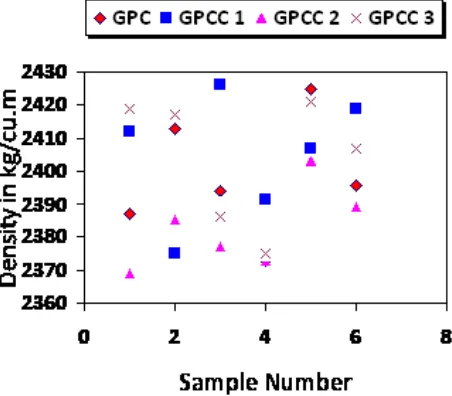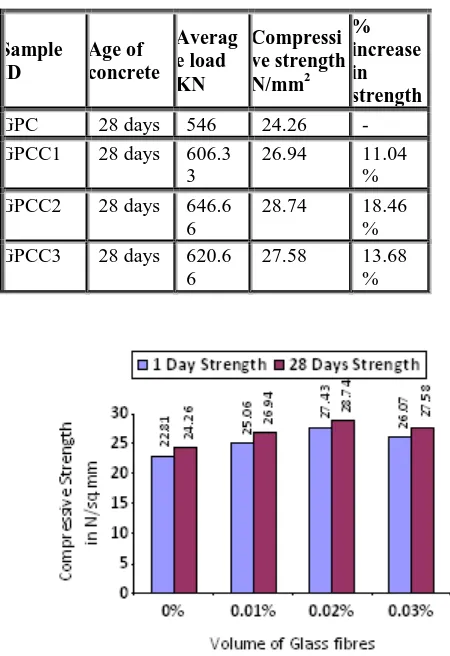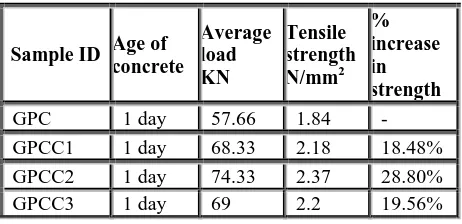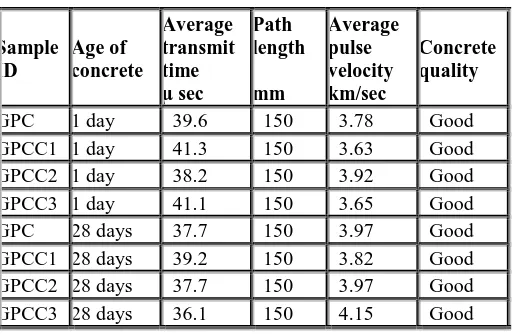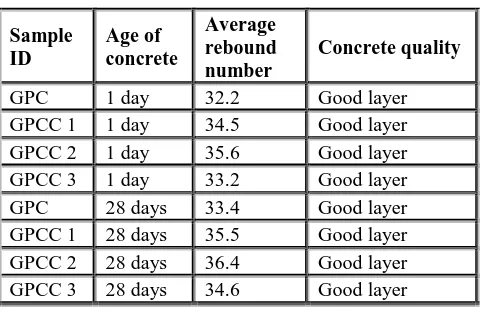Copyright to IJIRSET DOI:10.15680/IJIRSET.2015.0406219 4409
Properties and Strength of Glass Fibre
Reinforced Geopolymer Concrete
P. Sachithanandam
1, T.P. Meikandaan*
21
Assistant Professor, Department of Civil Engineering, Bharath University, Chennai, India
2*Assistant Professor, Department of Civil Engineering, Bharath University, Chennai, India
ABSTRACT: Concrete is one of the most widely used construction material, it is usually associated with Portland cement
as the primary binder. The production of one tonne of cement emits approximately one tonne of carbon-di-oxide in to the atmosphere which contributes to the global warming. On the other hand huge volume of fly ash is disposed in to the landfill which affects the surface bodies of fresh water and aquifers. An effort in this regard is the development of Geopolymer concrete. In this work low calcium fly ash based geopolymer is used as the binder instead of Portland cement paste to produce concrete. This paper presents the results of an experimental program on the mechanical properties of Geopolymer Concrete Composites (GPCC) containing Fly ash (FA), alkaline liquids and glass fibres. Alkaline liquid to fly ash ratio was fixed as 0.4 with 100% replacement of OPC. Glass fibres were added to the mix in 0.01%, 0.02% and 0.03% by volume of concrete. Based on the test results, the Geopolymer concrete composites have relatively higher strength in short curing time (one day) than the Geopolymer concrete and ordinary Portland cement concrete.
KEYWORDS: Fly ash, Geopolymer Concrete Composites, Alkaline Liquids, Glass Fibres, Density, Compression Test,
Split Tensile Test, Ultrasonic Pulse Velocity Test, Rebound Hammer Test.
I. INTRODUCTION
GEOPOLYMER
Davidovits proposed that an alkaline liquid could be used to react with the silicon (Si) and the aluminum (Al) in a source material of geological origin or in by-product materials such as fly ash and rice husk ash to produce binders. Because the chemical reaction that takes place in this case is a polymerization process, he coined the term „Geopolymer‟ to represent these binders. The properties of Geopolymer include high early strength, low shrinkage, freeze-thaw resistance, sulphate resistance and corrosion resistance. These high-alkali binders do not generate any alkali-aggregate reaction. The
Geopolymer binder is a low-CO2cementious material.
Production of Portland cement is currently exceeding 2.6 billion tons per year worldwide and growing at 5 percent annually. The global warming is caused by the emission of greenhouse gases, such as carbon-di-oxide, to the atmosphere by human activities. Among the greenhouse gases, carbon-di-oxide contributes about 65% of global warming. Although the use of Portland cement is still unavoidable until the foreseeable future, many efforts are being made in order to reduce the use of Portland cement in concrete. These efforts include the utilization of supplementary cementing materials such as fly ash, silica fume, granulated blast furnace slag, rice-husk ash and finding alternative binders to Portland cement.
Copyright to IJIRSET DOI:10.15680/IJIRSET.2015.0406219 4410
about 80%. Also the concept of using fibres as reinforcement is not new .By the 1960s, steel, glass (GFRC), and synthetic fibres such as polypropylene fibres (PFRC) were used in concrete, and research into new FRCs continues today. The addition of glass and polypropylene fibres to concrete increased the splitting tensile strength of concrete by approximately 20–50%.
Literatures indicated that several researchers have investigated the effect of inclusion of fibres in concrete consisting of either 100% cement or partial replacement of cement by fly ash. The present investigation is designed to evaluate the mechanical properties of glass fibre reinforced Geopolymer Concrete Composites consisting of 100% Fly ash and alkaline liquids.
II. EXPERIMENTAL INVESTIGATION MATERIALS
Fly Ash
Low calcium, Class F (American Society for Testing and Materials) dry fly ash obtained from Ennore Thermal Power Station-Chennai was used as the source material to make Geopolymer concrete in the laboratory [1].
Fine and Coarse Aggregates
Fine Aggregate (sand) used is clean dry river sand. Fine aggregate having a specific gravity of 2.75, bulk density of 1672 kg/m3 and fineness modulus of 2.41 was used. Coarse aggregates of 20 mm maximum size having a fineness modulus of 6.60, bulk density of 1515 kg/m3 and specific gravity of 2.68 were used [2].
Alkaline Liquid
A combination of Sodium hydroxide solution and sodium silicate solution was used as alkaline activators for Geopolymerisation [3]. Sodium hydroxide is available commercially in flakes or pellets form. For the present study, sodium hydroxide pellets with 98% purity were used for the preparation of alkaline solution. Sodium silicate is available commercially in solution form and hence it can be used as such. The chemical composition of sodium silicate is Na2
O:7.5-8.5%, SiO2:25-28%% and water:1.35 g/ml.To prepare 16 molarity concentration of sodium hydroxide solution, 640
grams (molarity x molecular weight) of sodium hydroxide pellets was dissolved in distilled water and makeup to one litre [4]. The sodium hydroxide solution thus prepared is mixed with sodium silicate solution one day before mixing the concrete to get the desired alkaline solution. The solids constituents of the GPCC mix i.e. fly ash and the aggregates were dry mixed in the pan mixer for about 3 minutes. After dry mixing, alkaline solution was added to the dry mix and wet mixing was done for 4 minutes. Finally extra water along with super plasticizer was added to achieve workable GPC mix. In case of glass fibre reinforced GPCC mix, fibres were added to the wet mix in three different proportions such as 0.01%, 0.02% and 0.03% volume of the concrete.In this experimental work a total of 48 numbers of concrete specimens were caste with and without glass fibres. The specimens considered in this study consisted of 24 numbers of 150mm side cubes and 24 numbers of 100mm diameter with 200mm long cylinders [5-6].
Copyright to IJIRSET DOI:10.15680/IJIRSET.2015.0406219 4411
III.TEST RESULTS
Density
Density of Geopolymer concrete composites is presented in Figure 1. Average Density values of Geopolymer concrete composites ranges from 2369 to 2426 kg/m3. The density of Geopolymer concrete composites was found approximately equivalent to that of conventional concrete [8].
Figure 4.1 Density of the samples
Compressive Strength
Copyright to IJIRSET DOI:10.15680/IJIRSET.2015.0406219 4412
Table 4.1 Compressive strength of samples after 1day
Table 4.2 Compressive strength of samples after 28 days
Figure 4.2 Compressive strength
Sample ID Age of
concrete
Average load KN
Compressive strength
N/mm2
% increase in strength
GPC 1 day 513.34 22.81 -
GPCC1 1 day 564 25.06 9.86%
GPCC2 1 day 617.33 27.43 20.25%
GPCC3 1 day 586.66 26.07 14.29%
Sample ID
Age of concrete
Averag e load KN
Compressi ve strength
N/mm2
% increase in strength
GPC 28 days 546 24.26 -
GPCC1 28 days 606.3
3
26.94 11.04
%
GPCC2 28 days 646.6
6
28.74 18.46
%
GPCC3 28 days 620.6
6
27.58 13.68
Copyright to IJIRSET DOI:10.15680/IJIRSET.2015.0406219 4413
Split Tensile Strength
The average tensile strength of GPC and GPCC at the age of 1 day and 28 days for 24 hours heat curing is given below [11]. As the age of concrete increases from 1 day to 28 days, tensile strength also increases for all the mixes. However, the increase in strength beyond 1 day is not significant. From the test results it can be seen that, average tensile strength of GPCC1 and GPPC2 were increased with respect to that of the GPC mix, while the compressive strength of GPCC3 was decreased gradually with respect to that of the GPCC2 mix. The increase in 1 day tensile strength was about 18% and 29% for GPCC1 and GPCC2
with respect to GPC mix and decrease in 1 day tensile strength was about 10% for GPCC3 with respect to GPCC2 mix is clearly given in the table [15]. Based on the test results of this investigation, the equation for predicting the split tensile strength of glass fibre reinforced Geopolymer concrete composites in terms of its compressive strength is given in as
fst= 0.084fcs. where,
fst = Split tensile strength of glass fibre reinforced Geopolymer concrete composites.
fcs = Compressive strength of glass fibre reinforced Geopolymer concrete composites.
Table 4.3 Tensile strength of samples after 1day
Table 4.4 Tensile strength of samples after 28 days
Sample ID Age of
concrete
Average load KN
Tensile strength
N/mm2
% increase in strength
GPC 1 day 57.66 1.84 -
GPCC1 1 day 68.33 2.18 18.48%
GPCC2 1 day 74.33 2.37 28.80%
GPCC3 1 day 69 2.2 19.56%
Sample ID Age of
concrete
Average load KN
Tensile strength
N/mm2
% increase in strength
GPC 28 days 60.66 1.93 -
GPCC1 28 days 72.33 2.3 19.17%
GPCC2 28 days 78.66 2.5 29.53%
Copyright to IJIRSET DOI:10.15680/IJIRSET.2015.0406219 4414
Figure 4.3 Split tensile strength
Ultrasonic Pulse velocity test
The Ultrasonic pulse velocity meter is used to determine the homogeneity of concrete. It depends on the materials and the mix proportion used in making concrete and it is related to its density and modulus of elasticity. From the test results given below, it can be seen that the quality of the Glass fibre reinforced Geopolymer concrete is good [12].
Rebound hammer test
Structural health monitoring of any structure is being carried out by Rebound hammer [13-14]. The result depends on the hardness of the concrete. From the test results given below, it can be seen that the Glass fibre reinforced Geopolymer concrete has good surface layer.
Table 4.5 Ultrasonic pulse velocity of cubes
Sample ID
Age of concrete
Average transmit time µ sec
Path length
mm
Average pulse velocity km/sec
Concrete quality
GPC 1 day 39.6 150 3.78 Good
GPCC1 1 day 41.3 150 3.63 Good
GPCC2 1 day 38.2 150 3.92 Good
GPCC3 1 day 41.1 150 3.65 Good
GPC 28 days 37.7 150 3.97 Good
GPCC1 28 days 39.2 150 3.82 Good
GPCC2 28 days 37.7 150 3.97 Good
Copyright to IJIRSET DOI:10.15680/IJIRSET.2015.0406219 4415
Table 4.6 Rebound hammer test
III.CONCLUSION
Based on the experimental work, the following conclusions are drawn:
1. Fibre reinforced fly ash geopolymer concrete will completely eliminate the use of cement in concrete.
2. Fibre reinforced fly ash geopolymer concrete helps in faster construction as it attains its strength in 1day curing. 3. The results from the ultrasonic pulse velocity test and Rebound hammer test prove that the Glass fibre reinforced
concrete have Good quality.
4. Geopolymer concrete can be widely used in manufacture of precast structure in industries.
5. The density of geopolymer concrete composites was found approximately equivalent to that of conventional concrete.
6. The increase in compressive strength was about 10% and 20% for GPCC 1 and GPCC 2 with respect to GPC mix and
decrease in compressive strength was about 5% for GPCC 3 with respect to GPCC 2 mix.
7. The increase in tensile strength was about 18% and 29% for GPCC 1 and GPCC 2 with respect to GPC mix and decrease in tensile strength was about 10% for GPCC 3 with respect to GPCC 2 mix.
8. Geopolymer concrete manufacture found to be costly. We can reduce the rate up to 20% to 30% if the raw materials
are purchased in bulk from the manufactures. Then comparing with plain cement concrete the manufacture of fly ash based geopolymer concrete will be only 20% to 30% higher.
REFERENCES
[1] Temuujin J, Van Riessen A, MacKenzie KJD (2010) “Preparation and characterisation of fly ashbased geopolymer mortars”-Construction and Building Materials, 24(2010) 1906-10.
[2] Jagannadha Rao K, Ahmed Khan T (2009) “Suitability of glass fibers in high strength recycled aggregate concrete”-An experimental investigation, Asian Journal of Civil Engineering(Building and& Housing), No. 6, 10(2009) 681-9.
[3] Subhashree A.R., Shanthi B., Parameaswari P.J., "The Red Cell Distribution Width as a sensitive biomarker for assessing the pulmonary function in automobile welders- a cross sectional study", Journal of Clinical and Diagnostic Research, ISSN : 0973 - 709X, 7(1) (2013) PP. 89-92.
[4] B. V. Rangan (2008) “Fly ash-based geopolymer concrete”-Research Report GC 4 Curtin University of Technology, Perth, Australia.
[5] Gopalakrishnan K., Prem Jeya Kumar M., Sundeep Aanand J., Udayakumar R., "Analysis of static and dynamic load on hydrostatic bearing with variable viscosity and pressure", Indian Journal of Science and Technology, ISSN : 0974-6846, 6(S6) (2013) PP.4783-4788.
Sample ID
Age of concrete
Average rebound number
Concrete quality
GPC 1 day 32.2 Good layer
GPCC 1 1 day 34.5 Good layer
GPCC 2 1 day 35.6 Good layer
GPCC 3 1 day 33.2 Good layer
GPC 28 days 33.4 Good layer
GPCC 1 28 days 35.5 Good layer
GPCC 2 28 days 36.4 Good layer
Copyright to IJIRSET DOI:10.15680/IJIRSET.2015.0406219 4416
[6] Nguyen Van Chanh1-Assoc. Professor. PhD., Bui Dang Trung, Dang Van Tuan-Candidate M.E.(2008) “Recent research geopolymer concrete”-University of Technology HCM City, Vietnam.
[7] Prasad MLV, Rathishkumar P (2007) “Strength studies on glass fiber reinforced recycled aggregate concrete”, Asian Journal of Civil Engineering (Building & Housing), No. 6,8(2007) 677-90.
[8] Kumar S.S., Rao M.R.K., Balasubramanian M.P., "Anticarcinogenic effects of indigofera aspalathoides on 20-methylcholanthrene induced fibrosarcoma in rats", Research Journal of Medicinal Plant, ISSN : 5(6) (2011) PP. 747-755.
[9] S. E. Wallah and B. V. Rangan (2006) “Low-calcium fly ash-based geopolymer concrete: long-term properties”-Research Report GC 2, Curtin University of Technology, Perth, Australia.
[10] Jaikumar S., Ramaswamy S., Asokan B.R., Mohan T., Gnanavel M., "Anti ulcer activity of methanolic extract of Jatropha curcas (Linn.) on Aspirin-induced gastric lesions in wistar strain rats", Research Journal of Pharmaceutical, Biological and Chemical Sciences, ISSN : 0975-8585, 1(4) (2010) PP.886-897.
[11] M.S.Shetty (2006) “Concrete technology”-S.Chand & Company Ltd.
[12] D. Hardjito and B. V. Rangan (2005) “Development and properties of low-calcium fly ash-based geopolymer concrete”-Research Report GC 1, Curtin University of Technology, Perth, Australia.
[13] Davidovits J (1994) “Global warming impact on the cement and aggregate industries”. WorldResources Review, 6(1994) 263-78.
[14] Srinivasan V., "Analysis of static and dynamic load on hydrostatic bearing with variable viscosity and pressure", Indian Journal of Science and Technology, ISSN : 0974-6846, 6(S6) (2013) PP.4777-4782.
[15] Davidovits J, Comrie DC, Paterson JH, Ritcey DJ (1990) “Geopolymeric concretes for environmental protection”-Concrete International: Design and Construction, No. 7,12 (1990)30-40
[16]AR.Arunachalam, Imperceptible Digital Image Watermarking, International Journal of Innovative Research in Computer and Communication Engineering, ISSN(Online): 2320-9801, pp 1321-1326, Volume 1, Issue 6, August 2013.
[17]AR.Arunachalam, Spectrum Reuse in Multiple Primary User
Environment, International Journal of Innovative Research in Computer and Communication Engineering, ISSN(Online): 2320-9801,pp 1475-1480, Volume 1, Issue 7, September 2013
[18]B.Sundar Raj, A Third Generation Automated Teller Machine
Using Universal Subscriber Module with Iris Recognition, International Journal of Innovative Research in Computer and Communication Engineering, ISSN (Online): 2320 – 9801,pp 565-571, Vol. 1, Issue 3, May 2013
[19]B.Sundar Raj, The Efficiency of the Scalable Architecture for
Revealing and Observing the Environment
using Wireless Sensor, International Journal of Innovative Research in Computer and Communication Engineering, ISSN (Online): 2320 – 9801,pp 63-67, Vol. 1, Issue 1, March 2013
